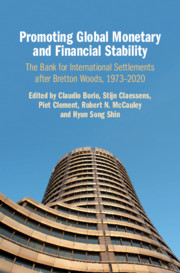 Promoting Global Monetary and Financial Stability
Promoting Global Monetary and Financial Stability Book contents
- Promoting Global Monetary and Financial Stability
- Studies in Macroeconomic History
- Promoting Global Monetary and Financial Stability
- Copyright page
- Contents
- Graphs and Tables
- Contributors
- Foreword
- Acknowledgements
- Abbreviations
- Introduction
- 1 The BIS and the European Monetary Experiment
- 2 The Governance of the Bank for International Settlements, 1973–2020
- The BIS in Pictures, 1973–2020
- 3 A Theory of Everything
- 4 Tower of Contrarian Thinking
- 5 Exchange Rates, Capital Flows and the Financial Cycle
- 6 The Bank for International Settlements
- Book part
- Note on Sources
- Bibliography
- Index
- Other Books in the Series (Continued from p. ii)
4 - Tower of Contrarian Thinking
How the BIS Helped Reframe Understandings of Financial Stability
Published online by Cambridge University Press: 10 April 2020
- Promoting Global Monetary and Financial Stability
- Studies in Macroeconomic History
- Promoting Global Monetary and Financial Stability
- Copyright page
- Contents
- Graphs and Tables
- Contributors
- Foreword
- Acknowledgements
- Abbreviations
- Introduction
- 1 The BIS and the European Monetary Experiment
- 2 The Governance of the Bank for International Settlements, 1973–2020
- The BIS in Pictures, 1973–2020
- 3 A Theory of Everything
- 4 Tower of Contrarian Thinking
- 5 Exchange Rates, Capital Flows and the Financial Cycle
- 6 The Bank for International Settlements
- Book part
- Note on Sources
- Bibliography
- Index
- Other Books in the Series (Continued from p. ii)
Summary
This chapter discusses the contribution of BIS research to the shift in the way financial stability issues have been looked at before and after the great financial crisis of 2007–9. It also considers the policy implications for the post-crisis reforms. The 1997–8 Asian crisis was an important turning point, focusing BIS research on the endogenous causes of financial instability and thus on the resilience and the risks of the financial system as a whole. From the late 1990s, the BIS started advocating a macroprudential approach to financial stability, including the adoption of countercyclical macroprudential policies. These ideas, while being shared by some academics and central banks, were largely ignored in policy circles, including in the Basel Committee on Banking Supervision. The chapter argues that the great financial crisis of 2007–9 catapulted these same ideas to the top of the reform agenda. Work done previously by the BIS and others, i.a. on the issue of countercyclical capital buffers, could be leveraged and find its way on the reform agenda pushed by the Financial Stability Board and the G20. The ‘measured contrarianism‘ of the BIS in this area thus added real value.
Keywords
- Type
- Chapter
- Information
- Promoting Global Monetary and Financial StabilityThe Bank for International Settlements after Bretton Woods, 1973–2020, pp. 134 - 167Publisher: Cambridge University PressPrint publication year: 2020
- 3
- Cited by
